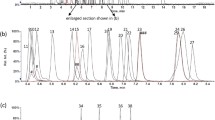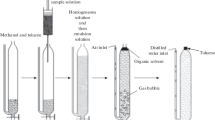Abstract
The carcinogenicity of petroleum products is mainly due to their content of polycyclic aromatic compounds (PACs). These compounds may be activated metabolically and react with DNA to form DNA adducts, which is a critical event in the initiation of cancer. One of the most common techniques for analyzing DNA adducts is 32P-postlabeling. The chromatographic method often used has been 32P-TLC (thin-layer chromatography), but the more recently developed 32P-HPLC (high-performance liquid chromatography) method has shown advantages. The aim of this study was to test the hypothesis that the 32P-HPLC method has a better ability of detecting DNA adducts derived from petroleum products than 32P-TLC. It was found that some DNA adducts migrated from the application point in 32P-TLC in such a way that it is doubtful if they could be detected and quantified properly. It was also found that, when using 32P-HPLC, it is possible to use the same protocol for substances with a wide variety of DNA adduct forming potential, whereas 32P-TLC needs to be optimized regarding time of exposure and/or the amount of DNA applied. Further, a pattern of recognition in 32P-HPLC enables a selective assessment of DNA adducts derived from complex mixtures whereas 32P-TLC is very limited when analyzing complex mixtures due to poor resolution. With more knowledge about the properties of the most mutagenic DNA adducts in HPLC, it could be possible to know also which pattern corresponds to a mutagenic or carcinogenic oil. Consequently, 32P-HPLC is a good alternative when assessing the genotoxicity of petroleum products.






Similar content being viewed by others
References
Akkineni LK, Zeisig M, Baranczewski P, Ekström L-G, Möller L (2001) Formation of DNA adducts from oil-derived products analyzed by 32P-HPLC. Arch Toxicol 74:720–731 [Erratum, Arch Toxicol 75:123–125]
Beach AC, Gupta RC (1992) Human biomonitoring and the 32P-postlabeling assay. Carcinogenesis 13:1053–1074
Beland FA, Kadlubar FF (1985) Formation and persistence of arylamine DNA adducts in vivo. Environ Health Perspect 62:19–30
Blackburn GR, Roy TA, Bleicher WT, Reddy MV, Mackerer CR (1996) Comparison of biological and chemical predictors of dermal carcinogenicity of petroleum oils. Polycyclic Aromatic Compounds 11:201–210
Booth ED, Brandt HCA, Loose RW, Watson WP (1998) Correlation of 32P-postlabeling-detection of DNA adducts in mouse skin in vivo with the polycyclic aromatic compound content and mutagenicity in Salmonella typhimurium of a range of oil products. Arch Toxicol 72:505–513
Carlberg CE, Möller L, Paakki P, Kantola M, Stockmann H, Purkunen R, Wagner P, Lauper U, Kaha M, Elovaara E, Kirkinen P, Pasanen M (2000) DNA adducts in human placenta as biomarkers for environmental pollution, analysed by the 32P-HPLC method. Biomarkers 5:182–191
Cui XS, Torndal UB, Eriksson LC, Möller L (1995) Early formation of DNA adducts compared with tumor formation in a long-term study in rats after administration of 2-nitrofluorene. Carcinogenesis 16:2135–2141
Dale CM, Garner RC (1996) Measurement of DNA adducts in humans after complex mixture exposure. Food Chem Toxicol 34:905–919
Dickson JR, Brinkman DW, Blackburn GR (1997) Evaluation of the dermal carcinogenic potential of re-refined base stocks using the modified Ames assay, PAC analysis and the 32P-postlabeling assay for DNA adduct induction. J Appl Toxicol 17:113–117
Dipple A, Pigott MA, Bigger CA, Blake DM (1984) 7,12-dimethylbenz[a]anthracene DNA binding in mouse skin: response of different mouse strains and effects of various modifiers of carcinogenesis. Carcinogenesis 5:1087–1090
Dipple A, Pigott MA, Agarwal SK, Yagi H, Sayer JM, Jerina DM (1987) Optically active benzo[c]phenanthrene diol epoxides bind extensively to adenine in DNA. Nature 327:535–536
Garner RC (1998) The role of DNA adducts in chemical carcinogenesis. Mutat Res 402:67–75
Gupta RC (1985) Enhanced sensitivity of 32P-postlabeling analysis of aromatic carcinogen: DNA adducts. Cancer Res 45:5656–5662
Gupta RC, Reddy MV, Randerath K (1982) 32P-Postlabeling analysis of nonradioactive aromatic carcinogen-DNA adducts. Carcinogenesis 12:1081–1092
Hemminki K (1993) DNA adducts, mutations and cancer. Carcinogenesis 14:2007–2012
IARC (International Agency for Reseach on Cancer) (1989) Monographs on the evaluation of Carcinogenic risks to humans, Vol 45. Occupational exposures in petroleum refining; crude oil and major petroleum fuels. IARC Press, Lyon, p 119
Ingram AJ, Phillips JC, Lee R (1995) DNA adduct formation by mineral oils and their fractions as indicated by 32P-postlabelling: is adduct formation truly indicative of carcinogenic potential? J Appl Toxicol 15:275–283
Ingram AJ, Phillips JC, Davies S (2000) DNA adducts produced by oils, oil fractions and polycyclic aromatic hydrocarbons in relation to repair processes and skin carcinogenesis. J Appl Toxicol 20:165–174
Koskinen M, Rajaniemi H, Hemminki K (1997) Analysis of tamoxifen-induced DNA adducts by 32P-postlabelling assay using different chromatographic techniques. J Chromatogr B Biomed Sci Appl 691:155–160
Maron DM, Ames BN (1983) Revised methods for Salmonella mutagenicity test. Mutat Res 113:173–215
Möller L, Zeisig M, Vodicka P (1993) Optimization of an HPLC method for analyses of 32P-postlabeled DNA adducts. Carcinogenesis 14:1343–1348
Möller L, Grzybowska E, Zeisig M, Cimander B, Hemminki K, Chorazy M (1996) Seasonal variation of DNA adduct pattern in human lymphocytes analyzed by 32P-HPLC. Carcinogenesis 17:61–66
Pfau W, Phillips DH (1991) Improved reversed-phase high-performance liquid chromatographic separation of 32P-labelled nucleoside 3′,5′-bisphosphate adducts of polycyclic aromatic hydrocarbons. J Chromatogr 570:65–76
Phillips DH, Castegnaro M, Bartch H (eds) (1993) IARC Scientific Publication 124. Postlabeling methods for detection of DNA adducts. International Agency for Research on Cancer, Lyon
Phillips DH, Farmer PB, Beland FA, Nath RG, Poirier MC, Reddy MV, Turteltaub KW (2000) Methods of DNA adduct determination and their application to testing compounds for genotoxicity. Environ Mol Mutagen 35:222–233
Poirier MC, Santella RM, Weston A (2000) Carcinogen macromolecular adducts and their measurement. Carcinogenesis 21:353–359
Randerath K, Reddy MV, Gupta RC (1981) 32P-labeling test for DNA damage. Proc Natl Acad Sci USA 78:6126–6129
Randerath K, Zhou G-D, Randerath E, Safe SH, Donnelly KC (1997) Comparative 32P-postlabeling analysis of exogenous and endogenous DNA adducts in mouse skin exposed to a wood-preserving waste extract, a complex mixture of polycyclic and polychlorinated chemicals. Environ Mol Mutagen 29:372–378
Reddy MV, Blackburn GR, Schreiner CA, Mackerer CR (1997) Correlation of mutagenic potencies of various petroleum oils and coal tar mixtures with DNA adduct levels in vitro. Mutat Res 378:89–95
Roy TA, Johnson SW, Blackburn GR, Mackerer CR (1988) Correlation of mutagenic and dermal carcinogenic activities of mineral oils with polycyclic aromatic compound content. Fundam Appl Toxicol 10:466–476
Srám RJ, Binková B (2000) Molecular epidemiology studies on occupational and environmental exposure to mutagens and carcinogens, 1997–1999. Environ Health Perspect 108: 57–70
Talaska G, Dooley KL, Kadlubar FF (1990) Detection and characterization of carcinogen-DNA adducts in exfoliated urothelial cells from 4-aminobiphenyl-treated dogs by 32P-postlabelling and subsequent thin-layer and high-pressure liquid chromatography. Carcinogenesis 11:639–646
Weyand EH, Rice JE, LaVoie EJ (1987) 32P-postlabeling analysis of DNA adducts from non-alternant PAH using thin-layer and high performance liquid chromatography. Cancer Lett 37:257–266
Zeisig M, Möller L (1997) 32P-Postlabeling high-performance liquid chromatographic improvements to characterize DNA adduct stereoisomers from benzo[a]pyrene and benzo[c]phenanthrene, and to separate DNA adducts from 7,12-dimethylbenz[a]anthracene. J Chromatogr B Biomed Sci Appl 691:341–350
Zeisig M, Hofer T, Cadet J, Möller L (1999) 32P-postlabeling high-performance liquid chromatography (32P-HPLC) adapted for analysis of 8-hydroxy-2′-deoxyguanosine. Carcinogenesis 7:1241–1245
Author information
Authors and Affiliations
Corresponding author
Rights and permissions
About this article
Cite this article
Eriksson, H.L., Zeisig, M., Ekström, LG. et al. 32P-postlabeling of DNA adducts arising from complex mixtures: HPLC versus TLC separation applied to adducts from petroleum products. Arch Toxicol 78, 174–181 (2004). https://doi.org/10.1007/s00204-003-0520-5
Received:
Accepted:
Published:
Issue Date:
DOI: https://doi.org/10.1007/s00204-003-0520-5




